Last month, the James Webb Space Telescope revealed high-resolution photos of distant galaxies, including “the deepest and sharpest infrared image of the distant universe,” according to NASA. While renewable energy is a hot topic right now on Earth–and perhaps a new one for a lot of people–what many don’t realize is that the adoption of solar panels in space contributed a large part to making solar more affordable for consumers. Technology had to be improved to make longer, further, and more complex missions. While we may no longer be in the age of the “Space Race,” advancements among the stars have helped ground solar power as reality here on Earth.
Let’s look back at how solar technology has evolved to allow us to look up.
1958: Vanguard 1 – The First Solar Panels in Space

Conception of Vanguard 1, which remains in Medium Earth Orbit (MEO) after a record-setting 60 years. Image credit: National Space Science Data Center
In 1958, less than six months after Sputnik 1–the first artificial satellite–and only a couple months before NASA was founded, the United States launched Vanguard 1 with the first six solar panels in space. Each measuring 5 cm x 5 cm, they produced 1 Watt of energy and were only 10% efficient. Vanguard 1 was “designed to test the launch capabilities of a three-stage launch vehicle” while also study the effects of space on a satellite and its instruments. While we no longer have communication with Vanguard 1, it remains the oldest man-made object in orbit to this day.
1966: Surveyor 1 – Solar Panels Survive on the Moon
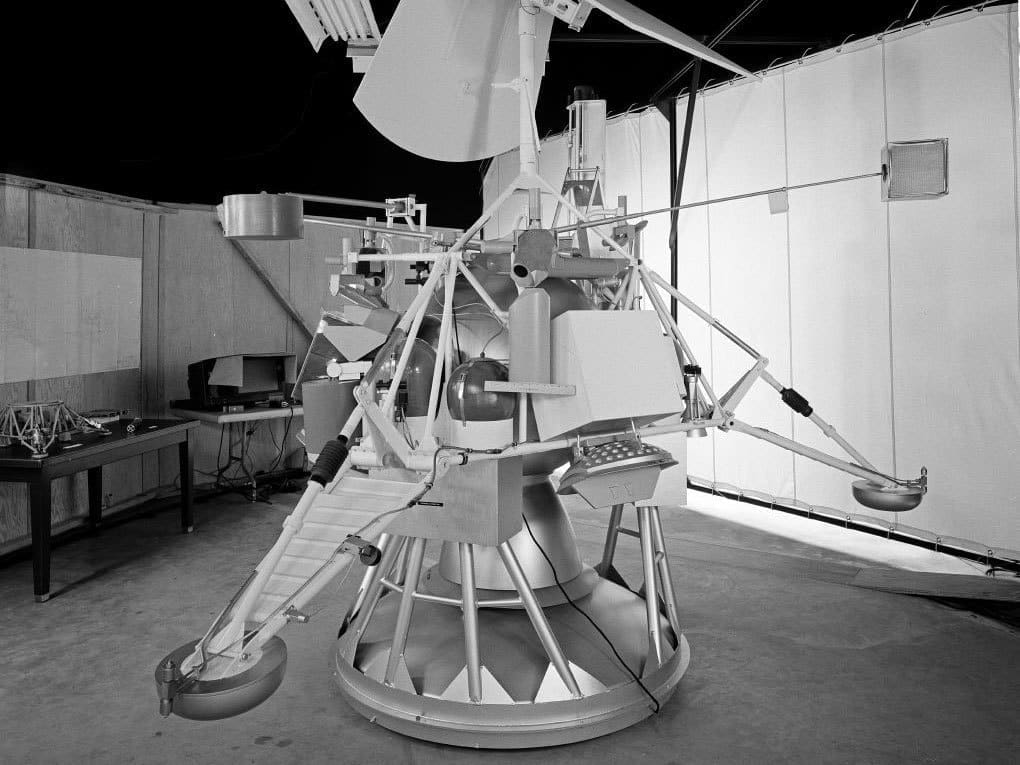
NASA’s Surveyor spacecraft. Image credit: NASA
Surveyor 1 made history as the first successful landing on the moon in 1966, after five of the nine solar-powered Ranger probes crash-landed on the moon between 1962-1965 and the other four never made contact. Surveyor 1’s 9.2-sq-ft solar array on the top of the mast generated 85 Watts of power as the spacecraft obtained data of the lunar surface. Surveyor 1 was the first mission in the Surveyor program designed to support and test technology for the upcoming crewed Apollo landings. 43 days and 11,240 photos after first touching down, the mission was terminated following a severe drop in battery just after sunset.
1967: Soyuz 1 – The First Solar-Powered, Crewed Spacecraft
Only six years after the first human in space, Soyuz 1 became the first crewed-spacecraft powered by solar panels, in 1967. Unfortunately, one solar panel did not unfurl properly, leading to a power shortage. After 18 orbits, Soyuz 1 returned to Earth, only to crash after a parachute malfunction, killing cosmonaut Vladimir Komarov in the crash. The Soyuz programmed was put on hold for 18 months for a spacecraft redesign.
1969: Apollo 11 – The First Men on the Moon
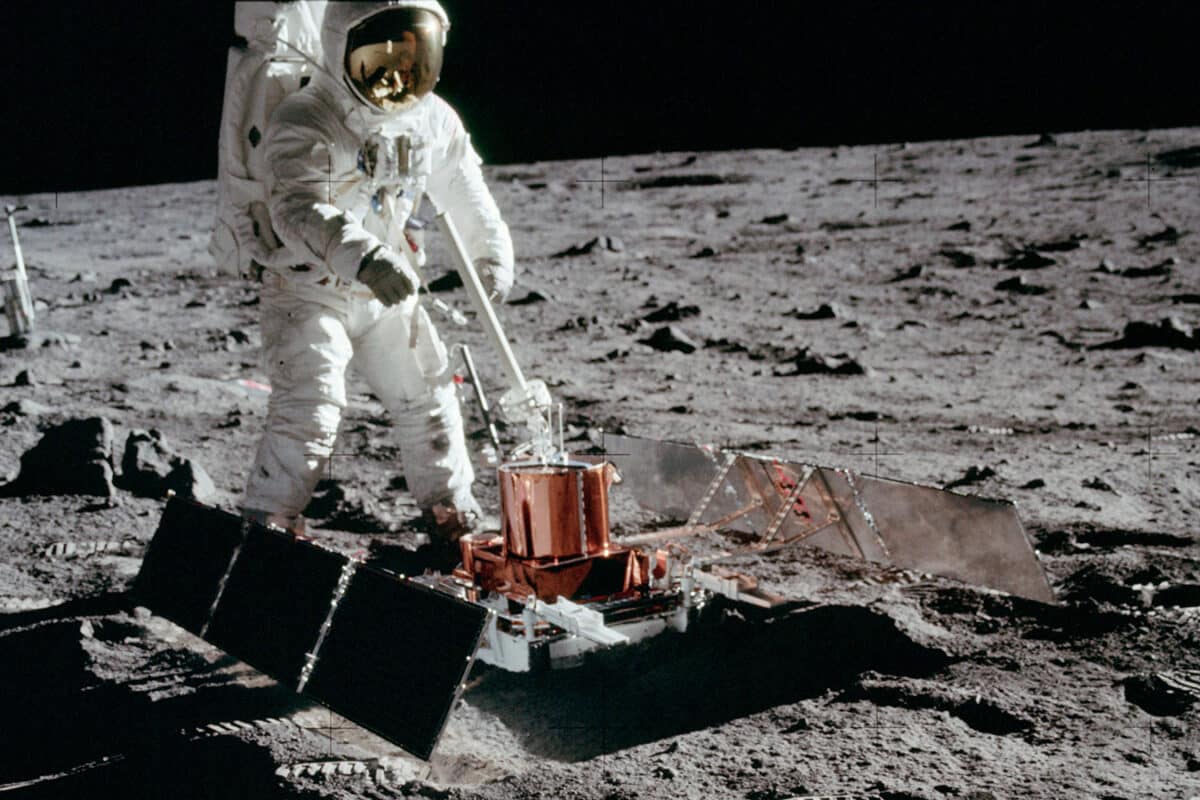
Apollo 11 astronaut Buzz Aldrin with the seismic experiment. Image credit: NASA
Arguably one of the most famous space missions occurred in 1969 when Apollo 11 brought Neil Armstrong and Buzz Aldrin as the first two men to walk on the moon. Also onboard was the Passive Seismic Experiment, a self-contained, solar-powered instrument that measured seismic activity and the physical properties of the lunar crust and interior. On August 27, 1969, ground teams lost communication with the instrument and the experiment was terminated.
1971: Salyut 1 – The First Space Station
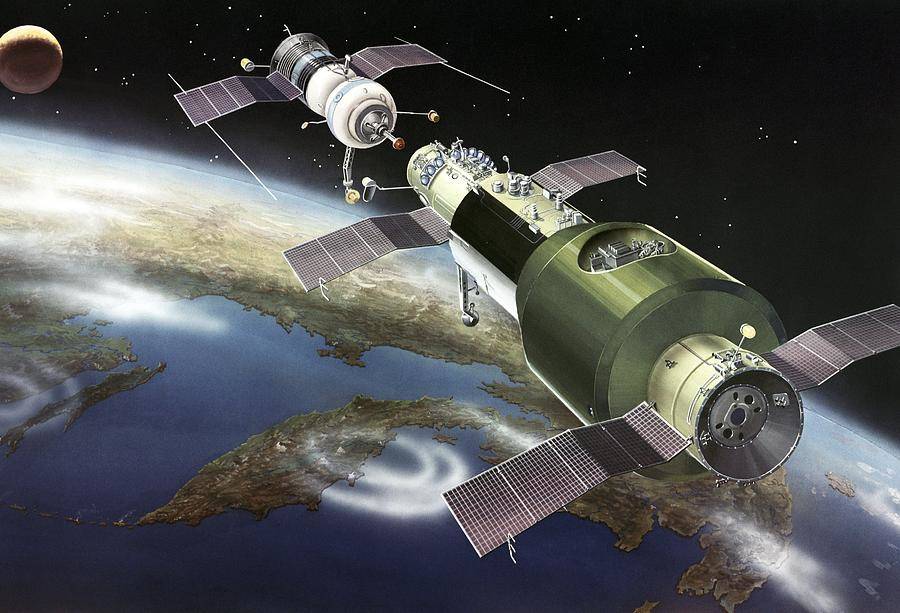
Illustration of the Salyut space station with a Soyuz crew transport spacecraft approaching at upper left. Credit: RIA-Novosti
In 1971, the Soviet Union launched the first space station, Salyut 1, designed for a six-month lifespan. Two double sets of solar panels extended from either end of the station like wings, with an area of 301 sq ft. After docking into Salyut 1 from Soyuz 11, cosmonaut crew members Georgi T. Dobrovolski, Vladislav N. Volkov, and Viktor set a then-record-setting 24-day mission. Shortly before their reentry into the Earth’s atmosphere, the crew perished when Soyuz 11 experienced a sudden depressurization. Future flights to Salyut 1 were cancelled while the Soyuz spacecrafts were once again redesigned, forcing controllers to send Salyut 1 into a destructive reentry over the Pacific Ocean after 175 days in space. To prevent a similar Soyuz 11 incident, cosmonauts to this day are required to wear pressure suits during launch and landing.
1973: Skylab 1 – The First Research Laboratory
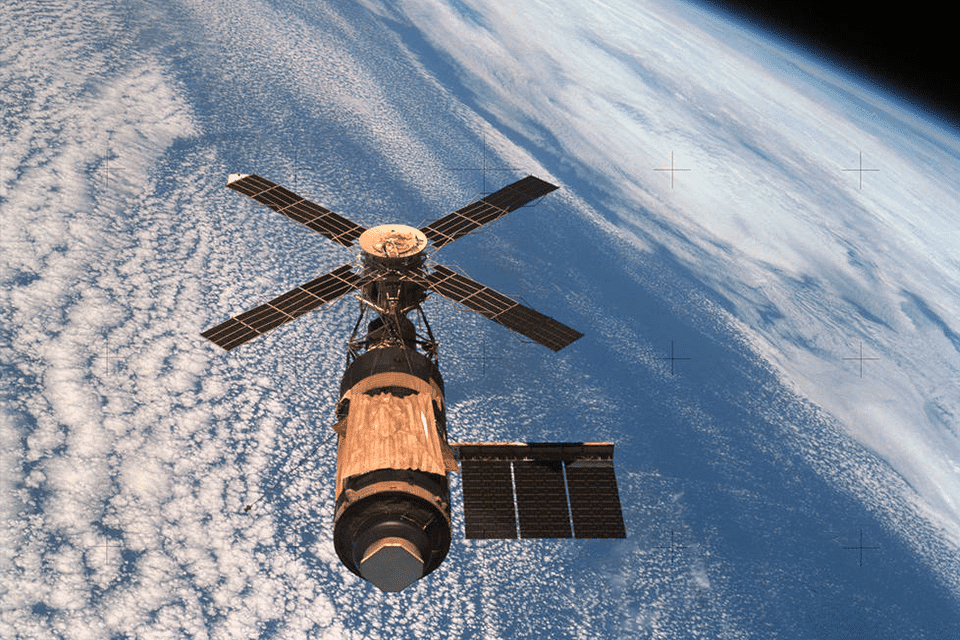
Skylab as it appeared to the final crew upon departure with the surviving array on the OWS. Image credit: NASA
It would take about 2 years before Skylab 1 was launched in 1973–America’s first space station and the first crewed, research laboratory in space. Skylab 1 was comprised of four components: the Orbital Workshop (OWS) with crew working/living quarters, the Airlock Module (AM) enabling spacewalks, the Multiple Docking Adapter (MDA) with docking ports for the Apollo shuttling spacecraft, and the Apollo Telescope Mount (ATM) with telescopes for solar observations. Two large solar arrays on the OWS extended 30 ft from the side of the spacecraft, providing 12.4 kW of power, and four 10-ft x 42-ft arrays on the ATM gave another 12 kW. About 63 seconds into the launch, the micrometeoroid shield–designed to serve as protection from debris and a thermal shield–prematurely deployed. Part of the torn shield jammed one of the solar arrays and the other tore off completely from aerodynamic forces, leaving the Skylab underpowered and overheating. Once in orbit, a sunshade was deployed to cool the spacecraft and the jammed solar array was freed, saving the mission. In 1979, Skylab 1 executed a planned, destructive reentry into the Earth’s atmosphere.
1986: Mir Space Station – Modularity and Extended Stays in Space
Left: Mir Sphotographed by the STS-91 crew in 1998. Image credit: NASA. Right: Color-coordinated components of Mir. Image credit: University of Texas
In 1986, the Soviet Union launched the Core Module for the Mir Space Station. Surviving 15 years in orbit–three times its expected lifespan and outliving the U.S.S.R.–Mir hosted both over 100 space travelers from a dozen countries and numerous records:
- The first major technical partnership between Russia and the United States
- The first seed-to-seed crop grown in space (wheat in this instance)
- The longest single-flight duration at 437 days, 17 hours, and 38 minutes by physician Valeri Polyakov in 1995
- The longest single-flight duration by a female at 188 days, 4 hours, 00 minutes by Shannon Lucid in 1996
- The greatest total time in space with three missions, totaling 747 days, 14 hours, and 12 minutes by Sergei Avdeyev in 1999
Mir’s first building block, the Core Module, was launched in 1986 and provided living quarters, life support, power, research capabilities and two arrays with a combined 818 sq ft of solar panels. Kvant 1, launched in in 1987, provided additional research capabilities into astrophysics and an additional solar array for the Core Module, increasing the solar panel area to 1,055 square feet. 1989 added Kvant 2 with additional life support systems, power distribution, and the means to provide biological research data. Stationed perpendicularly opposite of Kvant 1, Kvant 2 sported two 286-sq-ft solar arrays, providing 6.9 kW of power. Originally berthed opposite of Kvant 2 in 1990 and then linked perpendicular to both Kvant 2 and the Core Module, Kristall brought retractable solar arrays spanning 118 ft, an androgynous docking system, and scientific equipment to develop biological and materials. Spektr was berthed opposite Kvant 2 in 1995 with four solar arrays and equipment for research into Earth’s atmosphere and natural resources. Spektr also served as the living quarters for U.S. astronauts until it was badly damaged from a crash with an unmanned resupply vessel in 1997. It lost pressure and electricity to the point it had to be shut down and sealed off from the remainder of the complex. In 1996, Priroda was the final block linked perpendicularly to the Core Module and carried research and remote sensing equipment. Unlike the others before it, Priroda had no solar arrays and had to rely on its internal batteries whenever it was not docked to Mir. A month later, the Mir Cooperative Solar Array (MCSA) was attached to Kvant 1, providing an additional 6 kW at 9 ft x 59 ft and serving as a critical electric power forecast for the upcoming International Space Station. In 2001, with attention and funding prioritized towards the new International Space Station. Mir was sunk into the Pacific Ocean.
1998-PRESENT: The International Space Station

International Space Station as it appeared in 2018. Image credit: NASA
The first segment of the International Space Station (ISS) launched 1998, fulfilling a vision NASA had been working towards since the 1950’s. The ISS took 10 years and over 30 missions to assemble–a result of a collaboration among five space agencies representing 15 countries. At 460 tons, the platform is about the size of a football field–four times as large as Mir and five times as large as Skylab. 250 miles above, the ISS orbits the Earth 16 times every 24 hours (once every 90 minutes).
The ISS has four pairs of solar arrays measuring 112 ft x 39 ft and containing a total of 262,400 solar cells over an area greater than half of a football field (and great enough to see by the naked eye from Earth). The wingspan of a pair of arrays measures 240 ft–longer than a Boeing 777’s wingspan (212 ft). Each panel has mechanical hinges that allow it to be folded like an accordion during delivery to space and deployed once in orbit. Once fully extended, the arrays are mounted and rotated on gimbals for maximum exposure to the sun. Altogether, the four pairs generate 160 kW–more than what is needed at one time, sending up to 60% of the electricity to charge the batteries when facing the sun.
Since 2000, the space station has been continuously occupied and, after several redesigns following the 1967 crash, Soyuz spacecrafts began ferrying astronauts to and from the ISS, powered by a 34-foot solar array. When the space shuttle retired in 2011, Soyuz spacecrafts became the only means of transportation to or from the ISS. At least one Soyuz spacecraft has always been at the station to serve as a lifeboat in case of emergencies.
The ISS has also hosted
- Peggy Whitson with the greatest cumulative time in space at 665 days on September 2, 2017
- Mark Vande Hei with the longest single spaceflight at 355 days on March 30, 2021
2012-2016: Rosetta and Juno – The Farthest From the Sun
Artistic rendering of ESA’s Rosetta (left) Juno orbiting Jupiter (right). Image credits: NASA/JPL-Caltech and ESA-C. Carreau/ATG medialab
In 2012, the European Space Agency’s Rosetta space probe set a record as the most distant, solar-powered emissary at 492 million miles from the sun, on it’s approach to comet 67P/Churyumov-Gerasimenko. Rosetta had two solar arrays, each roughly 45 ft long that generated a maximum of 1.5 kW at perihelion. Four years later, NASA’s Juno mission to Jupiter broke this record in 2016 at 493 million miles from the sun. Launched in 2011, Juno was the first solar-powered spacecraft designed to operate at such a great distance from the sun” with three 30-ft-long solar arrays containing 18,698 individual solar cells. While at Earth-distance from the sun, Juno’s arrays could generate 14 kW of electricity; however, at Jupiter the sun is 25 times less powerful and Juno was only able to generate 500 Watts–still more than enough for its mission, thanks to improved solar-cell performance and energy-efficient instruments. Juno’s mission was originally scheduled to end in July 2021, but has since been extended “through September 2025 or until the spacecraft’s end of life.”
2017-PRESENT: iROSA – New ISS Solar Arrays
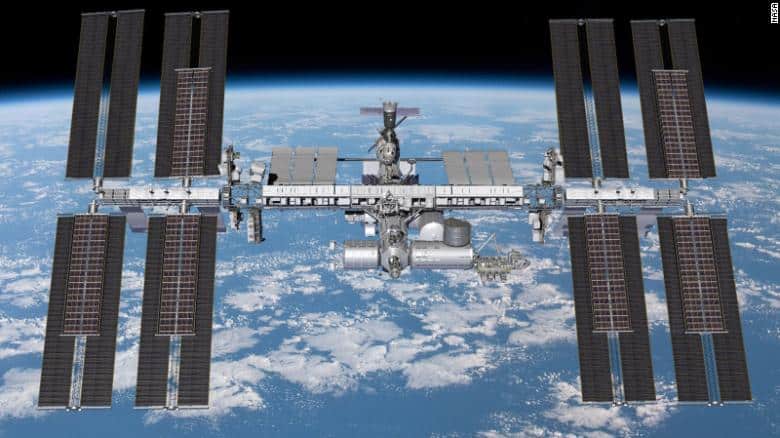
Rendering of the ISS once all six iROSAs have been deployed. Image credit: NASA
All but one of ISS’s four pairs of solar arrays have surpassed their designed 15-year service life. The initial pair was deployed in December 2000 and the others followed in September 2006, June 2007, and March 2009, dating the original pair to have been continuously powering the station, thousands of experiments, and hundreds of spacewalks for over 20 years. Though still performing well, there are obvious signs of degradation and solar technology has come a long way since the beginning of this century.
In 2017, the ISS tested a new design of solar array that didn’t rely on mechanical hinges to collapse. Called a Roll-Out Solar Array (ROSA), this new solar wing consists of two high strain composite booms holding a flexible material embedded with solar cells between them. ROSAs are launched as tight cylinders that roll open like a tape measure when deployed, and can be adapted into a variety of sizes. The 2017 test was just a fraction the size of existing arrays at 18 ft x 5.5 ft, with the existing arrays being 44-times larger. The trial run went successfully until operators attempted to retract the array. Stuck in the deployed configuration, the ISS ended up having to detach the ROSA from itself.
Despite the unfortunate finale, six ROSAs designed for the ISS–nicknamed “iROSAs“–are still planned to be positioned in front of the existing panels and augment the existing power supply. Larger than the 2017 test array and a little over half the size of existing arrays, each iROSA is 60 ft x 20 ft and cumulatively generate 120 kW. Each iROSA will partially shade the existing panel behind it, leaving the partially- and completely-uncovered arrays to generate about 95 kW cumulatively. The power generation augmentation brings the ISS’s total generation capabilities to 215 kW–a 20-30% increase from before. While larger than the 2017 ROSA, the iROSAs are 20% lighter and four-times smaller in volume than the existing, rigid panels. A difference that–according to Principal Investigator Jeremy Banik, a senior research engineer at the Air Force Research Laboratory, Kirtland Air Force Base in New Mexico–will have a “big cost savings from shaving off a little mass and volume…[making] it possible to raise bandwidth on a communications satellite and, for example, make GPS more accessible and reliable for everyone.”
The first pair of iROSAs were carried into space by SpaceX’s 215-ft Falcon 9 during CRS-22 Dragon on June 3, 2021. Installation occurred in mid-June over the course of three different spacewalks, after a couple of mechanical errors. While the final two iROSA pairs were initially planned on being launched in April 2022 and October 2022, respectively, current forecasts put the second pair on the SpaceX CRS-25 Dragon mission in late 2022, with no word yet on the third two.
2021: The First Controlled Flight on Another Planet
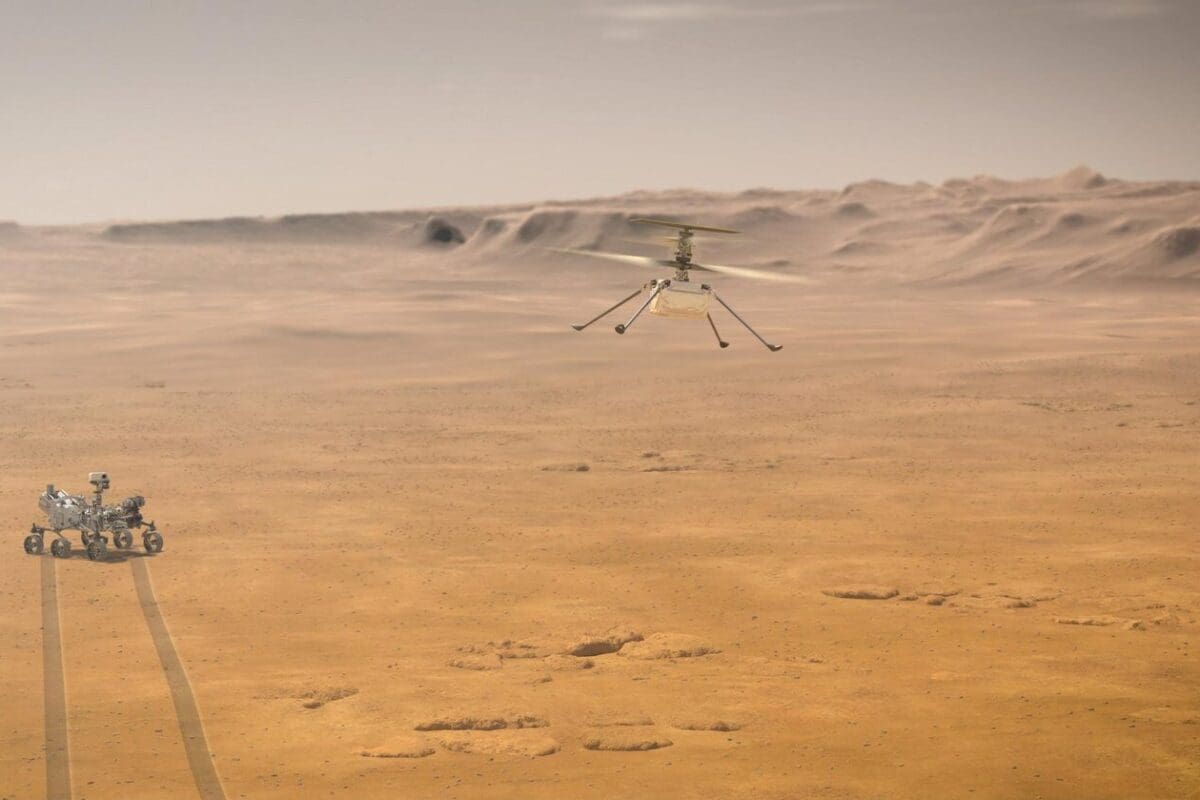
Artistic rendering of a Mars rover and a Mars flyer. Image credit: NASA/JPL-Caltech
On April 19, 2021, a solar-powered helicopter made history with a controlled flight on another planet. At 19.3 inches and 4 pounds, Ingenuity took off and landed onto the surface of Mars after 39.1 seconds and 10 ft in the air, in an area now known as Wright Brothers Field. Ingenuity was launched from Earth in 2020, strapped to Perseverance, who touched down on February 18. With one-third of Earth’s gravity, and 1% of Earth’s atmospheric pressure at the surface, this flight on Mars was a critical test of whether future Mars exploration (and maybe eventual colonization) could include an aerial dimension. Ingenuity has one solar panel, measuring 6.5 inches x 17 inches, that charges six internal, lithium-ion batteries.
2021-2022: DART – The First Asteroid Redirection Test

Illustration of how DART’s impact will alter the orbit of Dimorphos about Didymos. Image credit: NASA/JHU-APL
ROSA technology has also recently been used with NASA’s Double Asteroid Redirection Test (DART). Launched on November 23, 2021 via a SpaceX Falcon 9 rocket, DART is the world’s first full-scale mission of autonomous asteroid redirection technology. While there are no known asteroids or comets that pose a risk to Earth, NASA established the Planetary Defense Coordination Office in 2016 to manage preemptive measures. DART is just one tactic in NASA’s planetary defense strategy–deflecting oncoming objects off their predicted course with a kinetic impact to prevent a destructive collision with Earth’s surface or space missions. DART is expected to make impact with the Dimorphos moonlet asteroid in the Didymos asteroid system on September 26, 2022 at 3.9 miles per second (14,040 mph). Roughly 10 days before impact, DART will deploy solar-powered Light Italian CubeSat for Imaging of Asteroids (LICIACube) to photograph and analyze both the impact and resulting plume.
DART utilizes a variety of solar technology, including 27.9-foot-long ROSA solar arrays–their first time flying on a planetary spacecraft. With the ROSA structure, a small portion of DART’s solar array demonstrates new Transformational Array (TA) technology. With very-high-efficiency solar cells and reflective concentrators, the TA generates three-times more power than current solar array technology. DART will also be the first flight for NASA’s Evolutionary Xenon Thruster-Commercial (NEXT-C), a solar-powered electric propulsion system that uses electric and magnetic fields to efficiently create and accelerate ions, producing exhaust velocities over ten times higher than chemical rockets.
2022: James Webb Space Telescope – The Deepest Image of Space

Image credit: NASA/Desiree Stover
Launched on Christmas Day in 2021, the James Webb Space Telescope (JWST) is an orbiting infrared observatory meant to augment the Hubble Space Telescope with its improved sensitivity. The JWST’s 20-ft fold-out solar array generates 2 kW–more than the 1 kW of power needed–allowing for degradation in the harsh space environment.
On July 12, 2022, the JWST captured the deepest and sharpest image of the universe to-date. The image is about the size of a grain of sand from arm’s length away, composited of images at various different wavelengths, totaling 12.5 hours of exposure.
FUTURE: Gateway – Sustainability in Space

Illustration of Gateway in lunar orbit with contributions from international partners. Image credit: NASA
Originally dubbed the “Deep Space Habitat” in 2012, NASA’s Gateway, is a planned, multipurpose outpost orbiting the moon. This station is critical to NASA’s Artemis program, which hopes to maintain a sustainable presence on the moon while preparing for missions to Mars and beyond. The Gateway program is being built with both commercial and international partnerships and is a key element in NASA’s plan to return humans (including women and people of color) to the moon between 2024-2025. The first component to be launched will be the Power and Propulsion Element (PPE) with high-power solar arrays and solar electric propulsion (SEP) similar to NEXT-C. The PPE will be powered with two ROSAs generating 60 kW with an end-of-life power distribution capability of over 55 kW after 15 years. The ROSA circuits will also be modular–scalable and extendable to 300 kW.
Space-Based Solar Power – The Next Frontier?
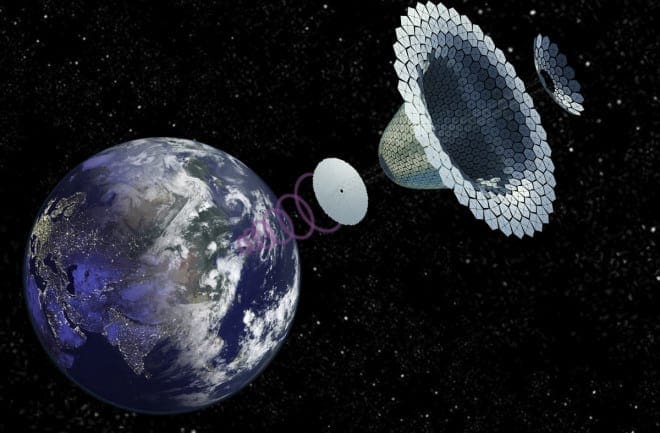
The SPS-Alpha solar satellite, shown in this illustration, uses a cone of mirrors to redirect sunlight onto photovoltaic panels. The energy is then converted to microwaves and beamed down to Earth. Image credit: John C. Mankins
Solar power generation has come a long way since the 1950’s. Records continue to be made and then broken, and technology is advancing in leaps and bounds. However, there is another form of solar power generation that even predates the Space Race–space-based solar power (SBSP). With SBSP, large solar arrays generate electricity in orbit and transmit it to Earth in the form of microwaves. Large antennas on the Earth’s surface capture the microwaves and convert it into usable electricity. SBSP would not be subjected to irregular solar radiation from fluctuating weather conditions or the 24-hour solar cycle. It would also prove higher efficiency at capturing solar energy, without atmospheric conditions reflecting a significant amount of light back into space. Overall, SBSP could generate up to 40 times more power annually than its counterparts on Earth.
American writer Isaac Asimov is credited with the idea in his science fiction short stories “Reason” and “The Last Question,” published in 1941 and 1956, respectively. Even though the rectenna was invented in 1964, converting microwave power into DC power, it wouldn’t be until 1968 that Dr. Peter Glasner seriously proposed the concept of SBSP, patenting the satellite in 1973. The next several decades wouldn’t see much progress, though various companies and countries revisited the idea occasionally: Boeing in 1982, NASA in 1995, Japan in 1998, and China and India jointly in 2012. The primary inhibator was the tremendous initial cost of getting the needed equipment in orbit. Until SpaceX was founded in 2002, rockets weren’t reusable. Now, both the launch of SBSP and technological advancements have become more accessible, leading NASA to reexamine SBSP viability and determine whether it may be a worthwhile step towards the national goal of “net zero” carbon emissions.



